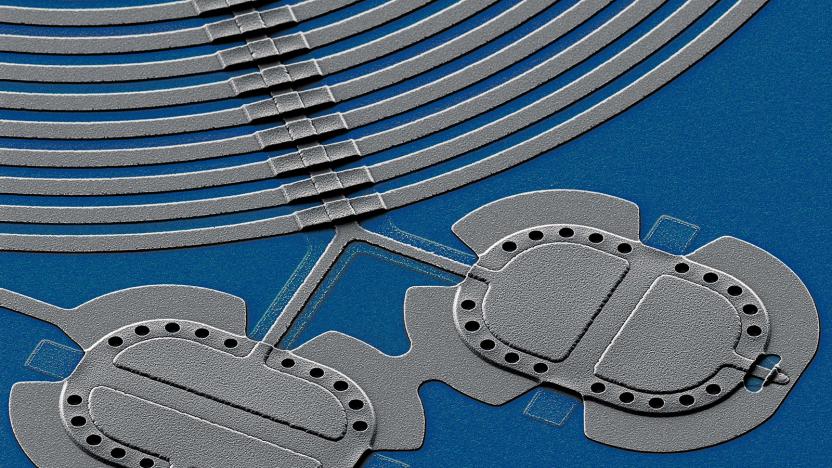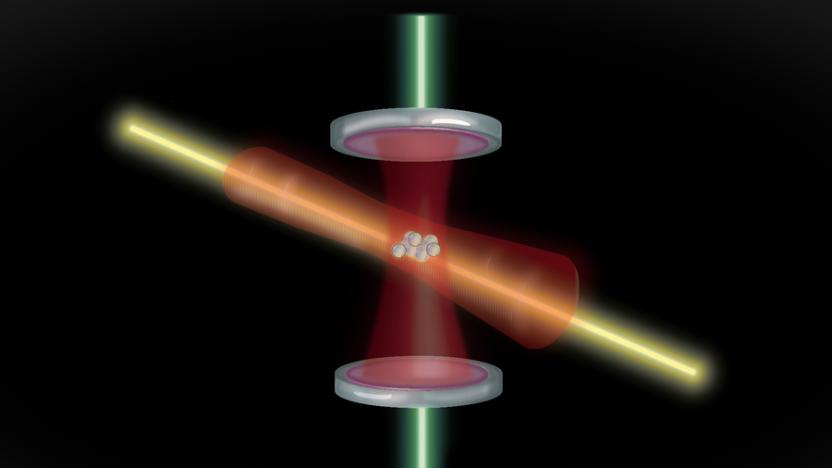quantum entanglement
Latest

Quantum drums could lead to more powerful computer networks
Scientists have built quantum-entangled drums whose synced beats could help create more powerful computer networks.

MIT researchers show quantum entanglement could make atomic clocks more accurate
It could help scientists explore issues such as the effect of gravity on time.

Energy Department unveils roadmap for a national quantum internet
The Energy Department has outlined plans for a national quantum internet that will use national labs as its heart.

Scientists unveil image of quantum entanglement for the first time ever
For the first time ever, physicists have captured an image of quantum entanglement. In a paper published in the journal of Scientific Advances, scientists from the University of Glasglow shared the first known image of a Bell entanglement. The photo depicts two photons interacting and sharing physical states for a brief instant -- an event that occurs regardless of the actual distance between the particles.

D-Wave One claims mantle of first commercial quantum computer
Whether or not D-Wave has actually built a quantum computer is still a matter of debate (though, a study authored by the company and published in Nature claims to prove its success) but, whatever it is these crafty Canadians have created, you can order one now and start crunching qubits with abandon. The D-Wave One is the first commercially available quantum computer and, while its 128-qubit processor can only handle very specific tasks and is easily outperformed by traditional CPUs, it could represent a revolution in the field of supercomputing. As D-Wave scales up to thousands or tens-of-thousands of qubits, complex number theory problems and advanced cryptographic systems could crumble before the mighty power of quantum annealing... or at least give us faster Google searches. Just out of curiosity, we contacted D-Wave to see how much we'd have to cough up for a quantum desktop of our own, but we've yet to hear back. Update: Joseph passed along an e-mail from the company with a little more information, including a price: $10,000,000. Yep, ten large, and we're not sure that includes the liquid helium required to keep it cooled.

Researchers show off scalable architecture for quantum computing, expand our minds
Okay, so we might be chasing the flying unicorn of modern technology here -- and, no, we're not talking about the white iPhone 4 -- but as you've probably noticed, our hunger for a quantum computer is basically insatiable. Lucky for us, some folks who actually know something about producing qubits are similarly persistent -- a team of researchers recently presented a scalable quantum chip at a meeting of the American Physical Society in good old Texas. The 6 x 6-cm processor sports four qubits, the basic units of quantum computing, and its creators say it has the potential to be scaled up to support 10 of the things within the year. So what does that mean for our quest for the ultimate super computer? Well, it means we're closer than we used to be... and the dream lives on.

Scientists create 10 billion qubits in silicon, get us closer than ever to quantum computing
We are totally ready for a quantum computer. Browse the dusty Engadget archives and you'll find many posts about the things, each charting another step along the way to our supposed quantum future. Here's another step, one that we think is a pretty big one. An international team of scientists has managed to generate 10 billion quantum entangled bits, the basic building block of a quantum computer, and embed them all in silicon which is, of course, the basic building block of a boring computer. It sounds like there's still some work to be done to enable the team to actually modify and read the states of those qubits, and probably a decade's worth of thumb-twiddling before they let any of us try to run Crysis on it, but yet another step has been made. [Image credit: Smite-Meister]

Danish scientists achieve advanced quantum teleportation
As you can imagine, here at Engadget, we love it when science fiction becomes more science and less fiction. With that in mind, we're pleased to pass along the news that Danish scientists at Copenhagen University have made a breakthrough in the wacky world of quantum teleportation by transporting quantum information over a distance of half a meter (1.6 feet). In order to achieve this, Dr. Eugene Polzik and his team shined a strong laser beam into a cloud of room-temperature cesium atoms that shared the same directional spin. As Scientific American reports: "The laser became entangled with the collective spin of the cloud, meaning that the quantum states of laser and gas shared the same amplitude but had opposite phases. The goal was to transfer, or teleport, the quantum state of a second light beam onto the cloud." (It should be noted that this process is more akin to duplication than actual teleportation, i.e. using this method on a human being would result in the formation of a doppelganger and not a magical Star Trek-like movement of matter). To achieve this goal, Polzik and other scientists added a second weaker laser pulse and split the two beams into separate branches in order to measure the difference between the quantum phases; through that measurement the scientists were then able to transfer the information of the spin state of the weak laser to the combination of the cesium atoms and the strong laser, without disturbing the quantum entanglement between the laser and the cesium. Umm, so the short of it is: one small step for a cesium atom, but one giant leap for quantum computing research and the advancement of teleportation theory.[Thanks, Josh H. and Eric M.]Read - ReutersRead - Scientific American





